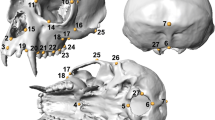Abstract
The drill (Mandrillus leucophaeus), a forest-living Old World monkey, is highly sexually dimorphic, with males exhibiting extreme secondary sexual characteristics, including growth of paranasal swellings on the muzzle. In this study, the size of the secondary bone that forms the paranasal swellings on the muzzles of drills was assessed in relation to body mass proxies. The relationship between the overall size of the muzzle and surrogate measures of body mass was also examined. In female drills, muzzle breadth was positively correlated with two proxies of overall body mass, greatest skull length and upper M1 area. However, there was no such correlation in males. Paranasal swellings in males also appeared to have no significant relationship to body mass proxies. This suggests that secondary bone growth on the muzzles of male drills is independent of overall body size. Furthermore, this secondary bone appears to be vermiculate, probably developing rapidly and in an irregular manner, with no correlation in the sizes of paranasal swelling height and breadth. However, various paranasal swelling dimensions were related to the size of the muzzle. It is suggested that the growth of the paranasal swellings and possibly the muzzle could be influenced by androgen production and reflect testes size and sperm motility. The size and appearance of the paranasal swellings may thus be an indicator of reproductive quality both to potential mates and male competitors. Further work is required to investigate the importance of the paranasal swellings as secondary sexual characteristics in Mandrillus and the relationship between body size and secondary sexual characteristics. Attention should also be paid to the mechanisms and trajectories of facial growth in Mandrillus.



Similar content being viewed by others
References
Compston JE (2001) Sex steroids and bone. Physiol Revs 81:419–447
Delson E, Terranova CJ, Jungers WL, Sargis EJ, Jablonski NG, Dechow PC (2000) Body mass in Cercopithecidae. Am Mus Nat Hist Anthropol Pap 83
Elton S, Bishop LC, Wood B (2001) Comparative context of Plio-Pleistocene hominin brain evolution. J Hum Evol 41:1–27
Freedman L (1957) The fossil Cercopithecoidea of South Africa. Ann Transvaal Mus 23 (part 2), p 137
Gartlan JS (1970) Preliminary notes on the ecology and behaviour of the drill, Mandrillus leucophaeus Ritgen 1824. In: Napier JR, Napier PH (eds) Old World monkeys: evolution, systematics and behaviour. Academic Press, New York, pp 445–480
Hill WCO (1970) Primates: comparative anatomy, and taxonomy, vol 8: Cynopithecinae. Edinburgh University Press, Edinburgh
Malo AF, Roldan ERS, Garde J, Soler AJ, Gomendio M (2005) Antlers honestly advertize sperm production and quality. Proc R Soc London Ser B 272:149–157
O’Higgins P, Collard M (2002) Sexual dimorphism and facial growth in papionin monkeys. J Zool London 257:255–272
Oyen OJ, Rice RW, Enlow DH (1981) Cortical surface patterns in human and nonhuman primates. Am J Phys Anthropol 54:415–419
Setchell JM, Dixson AF (2001) Changes in the secondary sexual adornments of male mandrills (Mandrillus sphinx) are associated with gain and loss of alpha status. Horm Behav 39:177–184
Setchell JM, Dixson AF (2002) Developmental variables and dominance rank in adolescent male mandrills (Mandrillus sphinx). Am J Primatol 56:9–25
Setchell JM, Lee PC, Wickings EJ, Dixson AF (2000) Growth and ontogeny of sexual size dimorphism in the mandrill (Mandrillus sphinx). Am J Phys Anthropol 115:349–360
Wickings EJ, Dixson AF (1992a) Testicular function, secondary sexual development and social status in male mandrills (Mandrillus sphinx). Phys Behav 52:909–916
Wickings EJ, Dixson AF (1992b) Development from birth to sexual maturity in a semi-free-ranging colony of mandrills (Mandrillus sphinx) in Gabon. J Reprod Fert 95:129–138
Wild C, Morgan BJ, Dixson AF (2005) Conservation of drill (Mandrillus leucophaeus) populations in Bakossiland, Cameroon: historical trends and current status. Int J Primatol 26:759–773
Acknowledgements
We thank CRES Cameroon for permission to use the M. leucophaeus cranial collection in their care. Some of these crania were collected by WWF Cameroon, and we thank them for their help. We also gratefully acknowledge the financial assistance provided by the Center for Conservation and Research for Endangered Species (CRES) of the Zoological Society of San Diego, the Margot Marsh Biodiversity Foundation, the Offield Family Foundation and the Nuffield Foundation. We are also grateful to the Government of Cameroon (MINFOF-DFAP and MINREST) for granting research permission to BJM. Finally, many thanks to Sam Cobb and Andrea Cardini for their helpful discussions of the ideas presented here, to Alan Dixson for reading this paper and making valuable comments and to Phyllis Lee and an anonymous reviewer for their help in improving this work.
Author information
Authors and Affiliations
Corresponding author
About this article
Cite this article
Elton, S., Morgan, B.J. Muzzle size, paranasal swelling size and body mass in Mandrillus leucophaeus. Primates 47, 151–157 (2006). https://doi.org/10.1007/s10329-005-0164-6
Received:
Accepted:
Published:
Issue Date:
DOI: https://doi.org/10.1007/s10329-005-0164-6




